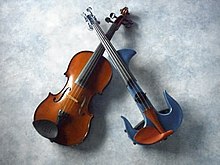Sound box



A resonance body is a body that can vibrate, which amplifies sounds or tones through resonance . Sound boxes are part of many musical instruments . Resonance bodies are mostly hollow bodies, the cavity is called a resonance chamber . A box-shaped resonance body (e.g. on the violin ) is also known as a resonance box.
Keyboard instruments like the grand piano have a soundboard . With them, the tones are primarily amplified by a vibrating wooden panel.
principle
A resonance body is part of a vibratory system. In the simplest case, it is a cavity with very specific dimensions , tuned to a very specific frequency (i.e. pitch ), for example with a tuning fork . Once excited, such an acoustic resonator vibrates at its natural frequency (in "body resonance ", see also resonance ). So it oscillates at the desired frequency and releases the oscillation into the air more intensely.
Resonance bodies can also be tuned to several frequencies. In musical instruments on which one can play many pitches, the resonance body is constructed in such a way that it has a large spectrum of natural frequencies, which ideally covers the entire range of the instrument; then the resonance body resonates well at all playable pitches. Efforts are made to enable many different vibration modes through appropriate shaping so that the tones played appear as loud as possible.
The larger the cavity resonator , the lower the natural frequencies. That is why a double bass is always considerably larger than a violin . With electronic amplification of the volume, a resonance body is not required. This is why an electric guitar , for example, is flatter than an acoustic guitar and usually has no cavity.
Musical instruments with and without a sound box
The sound box is an essential part of the following musical instruments:
- classical string instruments , e.g. B. violin , viola , cello and double bass
- most plucked instruments, e.g. B. acoustic guitar , mandolin , banjo , harp
- Boiler drums , e.g. B. Timpani
- Tubular drums , e.g. B. Dunun
For example, do not have a sound box:
- Wind instruments in which the sound is generated solely by the air flow, e.g. B. recorder
- accordion
- electromechanical musical instruments , e.g. B. electric guitar , electric bass , electric violin
- electronic musical instruments , e.g. B. Synthesizer (see also Electrophone )
- single-sided frame drums with a narrow frame, e.g. B. Tambourine
With organs , most pipes are labial pipes , these have no resonance body. With the reed pipes of the organ, however, the so-called bell serves as a resonance body.